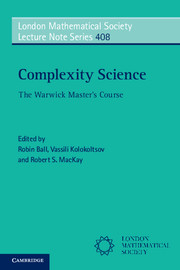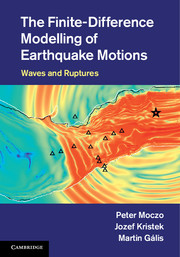Refine search
Actions for selected content:
6993 results in Mathematical modeling and methods
New regularity results and improved error estimates for optimal control problems with state constraints∗
-
- Journal:
- ESAIM: Control, Optimisation and Calculus of Variations / Volume 20 / Issue 3 / July 2014
- Published online by Cambridge University Press:
- 05 June 2014, pp. 803-822
- Print publication:
- July 2014
-
- Article
- Export citation
NEW DEVELOPMENT OF NONRIGID REGISTRATION
-
- Journal:
- The ANZIAM Journal / Volume 55 / Issue 3 / January 2014
- Published online by Cambridge University Press:
- 05 June 2014, pp. 289-297
-
- Article
-
- You have access
- Export citation
HOPF BIFURCATION ANALYSIS FOR A RATIO-DEPENDENT PREDATOR–PREY SYSTEM INVOLVING TWO DELAYS
- Part of
-
- Journal:
- The ANZIAM Journal / Volume 55 / Issue 3 / January 2014
- Published online by Cambridge University Press:
- 05 June 2014, pp. 214-231
-
- Article
-
- You have access
- Export citation

Complexity Science
- The Warwick Master's Course
-
- Published online:
- 05 June 2014
- Print publication:
- 21 November 2013
MEMBRANE-COUPLED GRAVITY WAVE SCATTERING BY A VERTICAL BARRIER WITH A GAP
- Part of
-
- Journal:
- The ANZIAM Journal / Volume 55 / Issue 3 / January 2014
- Published online by Cambridge University Press:
- 05 June 2014, pp. 267-288
-
- Article
-
- You have access
- Export citation
Global Carleman estimate for stochastic parabolic equations, and its application∗
-
- Journal:
- ESAIM: Control, Optimisation and Calculus of Variations / Volume 20 / Issue 3 / July 2014
- Published online by Cambridge University Press:
- 05 June 2014, pp. 823-839
- Print publication:
- July 2014
-
- Article
- Export citation
Control of underwater vehicles in inviscidfluids: I. Irrotational flows
-
- Journal:
- ESAIM: Control, Optimisation and Calculus of Variations / Volume 20 / Issue 3 / July 2014
- Published online by Cambridge University Press:
- 27 May 2014, pp. 662-703
- Print publication:
- July 2014
-
- Article
- Export citation
Linearized plastic plate models as Γ-limits of 3D finiteelastoplasticity
-
- Journal:
- ESAIM: Control, Optimisation and Calculus of Variations / Volume 20 / Issue 3 / July 2014
- Published online by Cambridge University Press:
- 27 May 2014, pp. 725-747
- Print publication:
- July 2014
-
- Article
- Export citation
Curve cuspless reconstruction via sub-Riemannian geometry∗∗∗
-
- Journal:
- ESAIM: Control, Optimisation and Calculus of Variations / Volume 20 / Issue 3 / July 2014
- Published online by Cambridge University Press:
- 27 May 2014, pp. 748-770
- Print publication:
- July 2014
-
- Article
- Export citation
The value function representing Hamilton–Jacobi equation with Hamiltonian depending on value of solution
-
- Journal:
- ESAIM: Control, Optimisation and Calculus of Variations / Volume 20 / Issue 3 / July 2014
- Published online by Cambridge University Press:
- 21 May 2014, pp. 771-802
- Print publication:
- July 2014
-
- Article
- Export citation
A deterministic affine-quadratic optimal control problem∗
-
- Journal:
- ESAIM: Control, Optimisation and Calculus of Variations / Volume 20 / Issue 3 / July 2014
- Published online by Cambridge University Press:
- 21 May 2014, pp. 633-661
- Print publication:
- July 2014
-
- Article
- Export citation

The Finite-Difference Modelling of Earthquake Motions
- Waves and Ruptures
-
- Published online:
- 05 May 2014
- Print publication:
- 24 April 2014
Contents
-
- Book:
- The Finite-Difference Modelling of Earthquake Motions
- Published online:
- 05 May 2014
- Print publication:
- 24 April 2014, pp vii-xiv
-
- Chapter
- Export citation
The Finite-Difference Modelling of Earthquake Motions - Half title page
-
- Book:
- The Finite-Difference Modelling of Earthquake Motions
- Published online:
- 05 May 2014
- Print publication:
- 24 April 2014, pp i-i
-
- Chapter
- Export citation
Part IV - Finite-difference modelling of seismic motion at real sites
-
- Book:
- The Finite-Difference Modelling of Earthquake Motions
- Published online:
- 05 May 2014
- Print publication:
- 24 April 2014, pp 305-326
-
- Chapter
- Export citation
Acknowledgements
-
- Book:
- The Finite-Difference Modelling of Earthquake Motions
- Published online:
- 05 May 2014
- Print publication:
- 24 April 2014, pp xv-xvi
-
- Chapter
- Export citation
17 - Traction-at-split-node modelling of dynamic rupture propagation
- from Part III - Finite-element method and hybrid finite-difference–finite-element method
-
- Book:
- The Finite-Difference Modelling of Earthquake Motions
- Published online:
- 05 May 2014
- Print publication:
- 24 April 2014, pp 285-294
-
- Chapter
- Export citation
Concluding remarks: search for the best scheme
- from Part IV - Finite-difference modelling of seismic motion at real sites
-
- Book:
- The Finite-Difference Modelling of Earthquake Motions
- Published online:
- 05 May 2014
- Print publication:
- 24 April 2014, pp 324-326
-
- Chapter
- Export citation
Index
-
- Book:
- The Finite-Difference Modelling of Earthquake Motions
- Published online:
- 05 May 2014
- Print publication:
- 24 April 2014, pp 363-365
-
- Chapter
- Export citation
1 - Introduction
-
- Book:
- The Finite-Difference Modelling of Earthquake Motions
- Published online:
- 05 May 2014
- Print publication:
- 24 April 2014, pp 1-4
-
- Chapter
- Export citation

